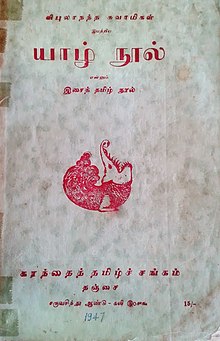Yazh Nool
 Cover page of Yazh Nool, 1947 | |
| Author | Swami Vipulananda |
|---|---|
| Original title | யாழ் நூல் |
| Country | Sri Lanka |
| Language | Tamil (some portions in English) |
| Subject | Tamil music |
| Genre | Musical treatise |
| Publisher | Karanthai Tamil Sangam, Yathumagi Printers |
Publication date | 1947 |
| Pages | ~97 |

Yazh Nool or Yal Nool (Tamil: யாழ் நூல்; pronounced [jɑːɻnuːl]; lit. The Book of Yazh) is a musical research book on yazh, one of the ancient musical instruments of the Tamils. The book was written by Swami Vipulananda , the worlds' first Tamil professor from Batticaloa,Sri Lanka published in June 1947 at Tirukkollampudur Vilvaranyeswarar Temple with the support of The Karanthai Tamil Sangam and financial support of Nachandupatti, P.RM.RM.ST Sitambaram Chettiar. The book is considered one of Vipulananda's significant works as well as an important treatise on the musical heritage of yazh.[1][2][3]
Background[edit]
The ancient poetic work Silappatikaram provides some details about ancient Tamil music and yazh. However, it does not accurately define Tamil music and yazh. Its poetic old Tamil is hard to understand in the modern Tamil language, and some Tamil scholars find it difficult to translate its teachings into a modern context. For these reasons, Swami Vipulananda undertook his research on Tamil music and yazh.[4]
Description[edit]
The book presents in-depth research on several ancient books that describe Tamil musical melody. It notably describes six different types of forgotten yazh instruments: Vil yazh, Peri yazh, Makara yazh, Cakota yazh, Seeri yazh, and Cenkotti yazh.[5] Swami Vipulananda spent 14 years researching the book.[6][7] The book has become the basis for the central concept of yazh and is used as a research tool by scholars.[8][9][10]
Publishing history[edit]
Three editions of the work have been published. The 1947 and 1974 editions were published by Karanthai Tamil Sangam; the second edition includes the author's English-language essay "A 1000-Stringed Yazh".[4] The third edition was published in 2003 by Yathumagi Printers in Tirunelveli.[5]
References[edit]
- ^ Xavier S., Thani Nayagam (1958). Tamil Culture, Volume 7. Academy of Tamil Culture.
- ^ Lal, Mohan (1992). Encyclopaedia of Indian Literature: Sasay to Zorgot. Vol. 5. Sahitya Akademi. p. 4581. ISBN 9788126012213.
- ^ K.G., Mahadeva (2005). Reminiscences. Mithra Arts & Creation Pvt. Ltd. p. 136.
- ^ a b விபுலானந்தர், சுவாமி (1974). யாழ் நூல். யாதுமாகி பதிப்பகம்.
- ^ a b Vipulananda, Swami (2003). Yazh Nool (3 ed.). Yathumagi Printers. pp. XXX, 31, 37, 47, 49.
- ^ "Founder: Swami Vipulanandar". Shivananda Vidyalayam (National School), Batticaloa. Archived from the original on 1 January 2017. Retrieved 1 January 2017.
- ^ "One hundred Tamils of the 20th century: Swami Vipulananda (1892–1947)". Tamilnation.org. 13 June 2007.
- ^ "விபுலாநந்த அடிகளார்". BBC. 2007.
- ^ "பேராசிரியர் சுவாமி விபுலானந்தரின் தமிழ்ப்பணிகள்". Ministry of Education, Sri Lanka.
- ^ Parthasarathy, T. S. (17 August 2004). "Book Review: Citadel of Arts". The Hindu. Retrieved 30 January 2017.
